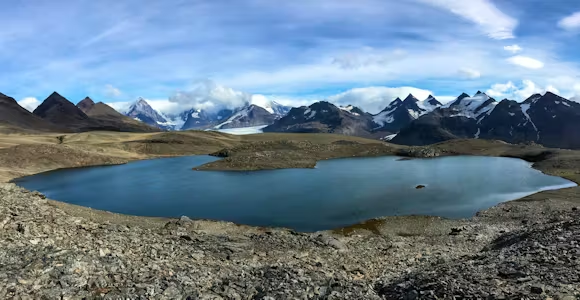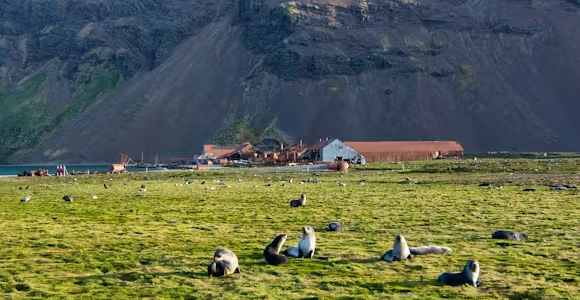
King Haakon Bay
King Haakon Bay was the terminus for Shackleton's epic boat journey from Elephant Island to South Georgia – a visit here is a trip highlight for many polar history enthusiasts.
Discover More
View of Elephant Island near Cape Valentine
Elephant Island is the northernmost of the South Shetland Islands. The British naval officer Edward Bransfield was the first person to sight it's mountainous coastline in February 1820. Bellinghausen visited a year later and named it Mordinov Island for the head of the Russian navy, but the name that stuck was given it by the sealer Robert Fildes visting at the same time and who recorded the large numbers of elephant seals here.
For all this, the name forever associated with Elephant Island is that of Sir Ernest Shackleton, who landed here in 1916 with his men after spending 170 days on the sea ice during his disastrous Endurance expedition. It was from here that Shackleton set sail in the James Caird to raise help on South Georgia: a visit to Point Wild where his crew camped while waiting rescue is a highlight for many people's Antarctic cruises, although no traces of their camp remain. It is a truly bleak spot exposed to the sea, while terrifyingly large glaciers loom nearby.
A bust of Captain Luis Pardo whose ship rescued the Endurance crew was erected on Point Wild in 1987. It makes a particularly incongruous sight when surrounded by chinstrap penguins.
The interior of Elephant Island is little explored, although two British Joint Services expeditions mountaineered here in the 1970s including the first ascent of its highest peak, Mount Pendragon (974m). In the 1980s, two refuge huts were built on the island by the Brazilian Antarctic Programme and are occasionally used by visiting researchers.

The Endurance Crew on Elephant Island
On April 5 1915, the 28 exhausted and frozen men of the Endurance led by Sir Ernest Shackleton landed at Cape Valentine on the eastern tip of Elephant Island. They had spent a brutal seven days in three tiny open boats to reach the island – a journey that Shackleton described as being the worst part of the entire expedition. When they staggered ashore it had been 497 days since any of them had stepped foot on land.
Cape Valentine was quickly abandoned as being too exposed to the tides and after a day's rest they relocated to Point Wild, a spot that was only marginally more hospitable. In a gale on their first night here, one of the men's tents were torn to shreds.
Within a week, Shackleton had fitted out the James Caird to set sail with five men for South Georgia 800 miles away to raise the alarm. Frank Wild was put in charge of those who stayed behind. The two remaining boats, the Stancomb Wills and the Dudley Docker were overturned and raised on rocks to form a rudimentary shelter.

Launching the James Caird from Elephant Island
Food was scarce. The remaining rations were eked out with penguins and limpets, but fears of starvation were real when the penguins started to leave the island to winter on the open seas. One crew member had saved a few scraps of a penny cookbook, and a page was read every night to indulge in debates over fantasy meals. The men were reduced to rags with faces blackened by blubber smoke. A banjo provided the only other entertainment.
Frank Wild ran as tight a camp as he could, setting strict routines to fend off the idleness that could easily lead to despair. Every day the men were roused with a cry of 'Lash up and stow [your belongings] – the Boss may come today!'
Despite this, rescue seemed distant. Shackleton's voyage to Haakon Bay in South Georgia and the subsequent hike across uncharted mountains was a herculean achievement, but it then took four attempts to reach Elephant Island with a rescue ship. The first three ships were turned back by sea ice.
'I felt jolly near blubbing for a bit & could not speak for several minutes,' Wild wrote later when salvation finally appeared on 25 August in the shape of the Chilean navy tug Yelcho under Shackleton's command. After being stranded for four and a half months, every man was safely taken offshore. Shackleton was invited to inspect their camp, but refused to step foot back on the island.

Chinstrap penguin colony at Point Wild on Elephant Island
Elephant Island is home to large numbers of chinstrap penguins. If you visit Point Wild, you will see them in large numbers here – the space where Shackleton's men made their camp is now the centre of a chinstrap rookery, extending all the way up the sheer sides of the rocky outcrop at the end of the point. Chinstraps are true mountaineers, with the claws of their webbed feet perfectly adapted to act as crampons as they hop their way up the rocks. Cape Petrels and snowy sheathbills also nest on the cliffs here.
Gentoo penguins can be found on other parts of the island with more gentle beaches. In these places you're also expected to find the island's eponymous elephant seals as well as fur seals, who appear to be resident here in increasing numbers.
The waters around Elephant Island are good for whale spotting, with sightings of fin whales and humpback whales common in the summer months. This particularly fruitful hunting area for the whaling industry, but recent surveys suggest that fin whales are now returning in increasing numbers to their historic feeding grounds here.
Price Match Promise - We’ll match any price you find elsewhere for the same trip
Elephant Island's location northeast of the South Shetlands means that it is typically only visited by expedition cruise ships crossing the Scotia Sea between South Georgia and the Antarctic Peninsula. Trips that visit the Peninsula only do not typically visit Elephant Island.
Ship's captains and expedition leaders well understand the totemic power of visiting Point Wild and if sea and weather conditions allow, many ships will attempt to call here. Zodiac cruises may or may not be offered: Point Wild is surrounded by hidden reefs and swells as well as facing the open ocean: conditions that may initially appear calm can change violently in minutes, making it unsafe to be out on the water. For this reason, landings are almost impossible. Remember that it took Shackleton four attempts to land here and rescue his men: this is not a place to be taken lightly.
NOTE: Ship itineraries and visits to specific locations in the Southern Ocean can never be guaranteed. Plans can change as fast as the polar weather: decisions on which locations to visit are always made on the day by the ship's captain and expedition leader.

King Haakon Bay was the terminus for Shackleton's epic boat journey from Elephant Island to South Georgia – a visit here is a trip highlight for many polar history enthusiasts.
Discover More
Fortuna Bay is home to one of South Georgia's most charming king penguin colonies, and offers the chance to recreate the historic Shackleton Walk to Stromness.
Discover More
Stromness is where Shackleton arrived at the end of his epic trek across South Georgia and remains the terminus for a popular hike from Fortuna Bay.
Discover More
Raise a toast to Shackleton and walk around the rusting ruins of the old whaling station at Grytviken, the historic heart of South Georgia.
Discover MoreWe'll spend some time listening to your aspirations, then discuss the kind of experience that might suit you.
Next we'll discuss the options, shortlist the best trips for you and present you our impartial recommendations.
We'll place a 24 hour hold on your preferred option - without obligation - whilst we talk through the details.